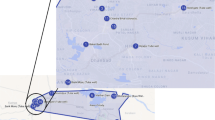Abstract
The concentrations of strontium, calcium, and magnesium in 33 brands of natural mineral waters commercially available in Japan were determined by inductively coupled plasma-atomic emission spectrometry. The geometric mean values were 94.4 μg/L for strontium, 19.1 mg/L for calcium, and 2.82 mg/L for magnesium. Wide confidence intervals of 1.96–4539 μg/L for strontium, 0.865–421 mg/L for calcium, and 0.064–123 mg/L for magnesium were observed. The significant linear relationships among the three elements over a wide distribution range suggest that the synchronized variations of these elements are regulated by the natural ecosystem and not from accidental contamination from human activities or exceptionally high natural sources. Using the results of multiple linear regression analysis, the strontium concentration can be predicted by that of calcium with the appropriate power function. The results of this study suggest that mineral water can be an important nutritional source of strontium. As trace elements imbalance is often found in older patients with chronic renal failure, we propose that close attention of trace elements intake from trendy foods or beverages is necessary to prevent this hidden problem of a rapidly aging society.
Similar content being viewed by others
References
The Mineral Water Association of Japan, Statistic of Mineral Water, The Mineral Water Association of Japan, Tokyo (2005)
M. Krachler, W. Domej, and K. J. Irgolic, Concentrations of trace elements in osteoarthritic knee-joint effusions, Biol. Trace Element Res. 75, 253–263 (2000).
M. Pi and L. D. Quarles, A novel cation-sensing mechanism in osteoblasts is a molecular target for strontium, J. Bone Miner Res. 19, 862–869 (2004).
J. Y. Reginster, N. Sarlet, E. Lejeune, and L. Leonori, Strontium ranelate: a new treatment for postmenopausal osteoporosis with a dual mode of action, Curr. Osteoporos. Rep. 3, 30–34 (2005).
S. Ozgur, H. Sumer, and G. Kocoglu, Rickets and soil strontium, Arch. Dis. Child. 75, 524–526 (1996).
E. B. Neufeld and A. L. Boskey, Strontium alters the complexed acidic phospholipid content of mineralizing tissues, Bone 15, 425–430 (1994).
I. Schrooten, G. J. Behets, W. E. Cabrera, et al., Dose-dependent effects of strontium on bone of chronic renal failure rats, Kidney Int. 63, 927–935 (2003).
M. E. De Broe and P. C. D'Haese, Strontium and osteomalacia in renal failure patients, Nephrol. Dial. Transplant. 18, 215–216 (2003).
S. Yafuji, Mineral water, Food Sci. 6, 22–43 (1995).
K. Usuda, K. Kono, T. Dote, et al., Log-normal distribution of the trace element data results from a mixture of stocahstic input and deterministic internal dynamics, Biol. Trace Element Res. 86, 45–54 (2002).
A. Misund, B. Frengstad, U. Siewers, and C. Reimann, Variation of 66 elements in European bottled mineral waters, Sci. Total Environ. 243/244, 21–41 (1999).
I. al-Saleh and I. al-Doush, Survey of trace elements in household and bottled drinking water samples collected in Riyadh, Saudi Arabia, Sci. Total Environ. 216, 181–192 (1998).
F. W. Clark, The Data of Geochemistry, Department of the Interior, United States Geological Survey Bulletin 770, US Geological Survey, Washington, DC (1924).
P. Varo, E. Saari, A. Paaso, and P. Koivistoinen, Strontium in Finnish foods, J. Vitam. Nutr. Res. 52, 342–350 (1982).
J. R. Coughlin, Sources of human exposure: overview of water supplies as sources of boron, Biol. Trace Element Res. 66, 87–100 (1998).
R. W. Dabeka, H. B. Conacher, J. F. Lawrence, et al., Survey of bottled drinking waters sold in Canada for chlorate, bromide, bromate, lead, cadmium and other trace elements, Food. Addit. Contam. 19, 721–732 (2002).
I. Schrooten, M. M. Elseviers, L. V. Lamberts, M. E. De Broe, and P. C. D'Haese, Increased serum strontium levels in dialysis patients: an epidemiological survey, Kidney Int. 56, 1886–1892 (1999).
K. Usuda, K. Kono, T. Watanabe, et al., Renal function decline in aged workers enhances toxic effect of occupational chemicals, in Aging and Work, M. Kumashiro, (ed.), Taylor & Francis, Boston, pp. 291–299 (2003).
K. Usuda, K. Kono, T. Watanabe, et al., Hemodialyzability of ionizable fluoride in hemodialysis session, Sci. Total Environ. 297, 183–191 (2002).
K. Usuda, K. Kono, K. Nishiura, et al., Boron diffusion across the dialysis membrane during hemodialysis, Miner. Electrolyte Metab. 23, 100–104 (1997).
K. Usuda, K. Kono, and Y. Yoshida, The effect of hemodialysis upon serum levels of fluoride, Nephron 75, 175–178 (1997).
J. P. Devogelaer and C. Nagant de Deuxchaisnes, Fluoride therapy of type I osteoporosis, Clin. Rheumatol. 14(Suppl. 3), 26–31 (1995).
C. Nagant de Deuxchaisnes, J. P. Devogelaer, and F. Stein, Fluoride treatment for osteoporosis, Lancet 336, 48–49 (1990).
S. L. Volpe, L. J. Taper, and S. Meacham, The relationship between boron and magnesium status and bone mineral density in the human: a review, Magnesium Res. 6, 291–296 (1993).
F. H. Nielsen, Studies on the relationship between boron and magnesium which possibly affects the formation and maintenance of bones, Magnesium Trace Element 9, 61–69 (1990).
C. H. Turner, I. Owan, E. J. Brizendine, W. Zhang, M. E. Wilson, and A. J. Dunipace, High fluoride intakes cause osteomalacia and diminished bone strength in rats with renal deficiency, Bone 19, 595–601 (1996).
K. Usuda, K. Kono, K. Iguchi, et al., Hemodialysis effect on serum boron level in the patients with long term hemodialysis, Sci. Total Environ. 191, 283–290 (1996).
P. C. D'Haese, N. M. Couttenye, L. V. Lamberts, et al., Aluminum, iron, lead, cadmium, copper, zinc, chromium, magnesium, strontium, and calcium content in bone of endstage renal failure patients, Clin. Chem. 45, 1548–1556 (1999).
M. Gallieni, D. Brancaccio M. Cozzolino, and E. Sabbioni, Trace elements in renal failure: are they clinically important?, Nephrol. Dial. Transplant 11, 1232–1235 (1996).
Statistics and Information Department, Minister's Secretariat, Ministry of Health, Labour and Welfare, Health and Welfare Statistics Association, Statistical Abstracts on Health and Welfare in Japan, Statistics and Information Department Minister's Secretariat, Ministry of Health, Labour and Welfare, Health and Welfare Statistics Association, Tokyo (2005).
Author information
Authors and Affiliations
Rights and permissions
About this article
Cite this article
Usuda, K., Kono, K., Dote, T. et al. Survey of strontium in mineral waters sold in Japan. Biol Trace Elem Res 112, 77–86 (2006). https://doi.org/10.1385/BTER:112:1:77
Received:
Accepted:
Issue Date:
DOI: https://doi.org/10.1385/BTER:112:1:77




